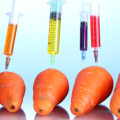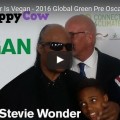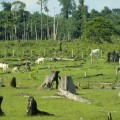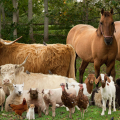It seems carnivores want to make us, vegetarians and vegans, out to be the environmental bad guys. As the Brazilian rainforest is being destroyed by illegal soybean plantations the finger is being pointed at us the biggest culprit. After all our diet is comprised of tofu, soymilk, soya yogurt, textures vegetable protein and soy flour, so it must be us who are single handedly destroying this unparalleled biodiversity. Except, of course, that according to Worldwatch Institute nearly 80 per cent of global soybean harvest is used to feed livestock.
This story has been making news this week first in the UK where a government adviser is creating headlines with a blanket call for everyone to go vegetarian. This was picked up by the New York Times and defended by a small time farmer who attempted to illustrate vegetarianism can be as dangerous as meat eating. Treehugger tried to travel the middle road.
So what have we got here?
Well let’s take another look at the stats – the leading producers of soybean crops in the world are: America, Brazil, Argentina and China. (China is also one of the biggest importers of the soybean). Eighty-five per cent of soybean crops in the US and 98 per cent of crops in Argentina are genetically modified. However, in both countries genetically modified and naturally grown soybeans can be mixed at any stage, there are no regulations to keep them separate. Even in Brazil what was once illegal, became smuggled and is now approved, 64 per cent of crops are genetically modified. Although in the Northern part of the country crops remain non-genetically modified.
As the people and the government of Brazil become more aware of the money to be made with soybean crops the rainforest slowly shrinks to be make room for more soybean production. And once a single crop has been harvested the soil is useless for any future planting. So we’re ending up with the depletion of the Amazonian rain forest which is killing off animals that depend on this unique ecosystem as well as erasing the cultural heritage of the people who once called this land home. We’re also getting tainted soybeans that, especially in North America, are harder to trace back to a guilt-free source. Except we as vegetarians and vegans can’t shoulder all the blame and the guilt as to reiterate what has already been said after the 80 per cent of crops that goes to feed animals that will one day soon be slaughtered, there is only 20 per cent left to be used for us protein starved lot who are just dying for their next dose of tofu steak. Not anyone you know? You mean the vegan and vegetarian diet has plenty of opportunities for getting the protein we need with or without soy products? Who would have thought?
What we really get when we look too closely at the issue are people defending whatever is important to them. So, if they’re a small independent farmer who feeds their livestock grain instead of soy they’re going to defend the consumption of meat. Their livelihood depends on it. If you’re an economist who has books to sell and governments to influence you can’t be seen to walk the middle ground you’re going to need to make a dramatic stance to get people’s attention. And if you’re a vegetarian whose entire lifestyle centers around protecting the welfare of animals you’re going to defend your prescribed beliefs.
As with anything, it all comes down to balance. Ensuring your good is not outweighed by your bad. So if you’re going to eat meat do your research and find that small, local farmer whose concerned about the environment. A local farmer with their environmental conscious intact will be a double win as the food won’t have to be shipped by land or air making them even cleaner for your own green slate. Of course if you’re vegetarian or vegan you’re already a step ahead because you don’t have to worry about how an animal is reared because you’re not about to see it on your own plate anytime soon. However, before you go ahead and start patting yourself on the back, do you actually know where your tofu, soymilk or tvp come from? If you live in the EU you can breath a little easier as only non-GM soy that has full traceability back to its source will be bought. If, on the other hand, you’re in North America the source of the soybeans is often not listed. You can buy American and risk genetically modified food or you can go organic and risk threatening the destruction of the rainforest and the life of the animals who depend on it. (Of course, you could take action to campaign to rid the world of genetically modified crops.) Whatever your diet, you need to be aware of where your food is coming from and the potential harm you could be doing. The world has gotten a whole lot smaller and what one country does impacts on the rest of us. Every decision counts.
For further reading visit all sides of the argument: the carnivore, the veggie and the environmentalist.
- Climate chief Lord Stern: give up meat to save the planet
- The Carnivore’s Dilemma
- Vegetarian’s Rebuttal to ‘The Carnivore’s Dilemma’






1 Comment
Chia (324 comments)
December 14, 2009 at 7:37 pmExcellent article. Thank you for bringing attention to this subject. Soybeans and corn are highly genetically modified commodies, and they are mainly used to feed livestock which are then slaughtered to feed humans. I live in the USA, and whenever possible, I consume only ORGANIC soy products, i.e. tofu and soymilk (mainly). I usually buy the “Wildwood” brand which uses only organically grown soybeans grown in the USA. Please read your labels and buy organic!